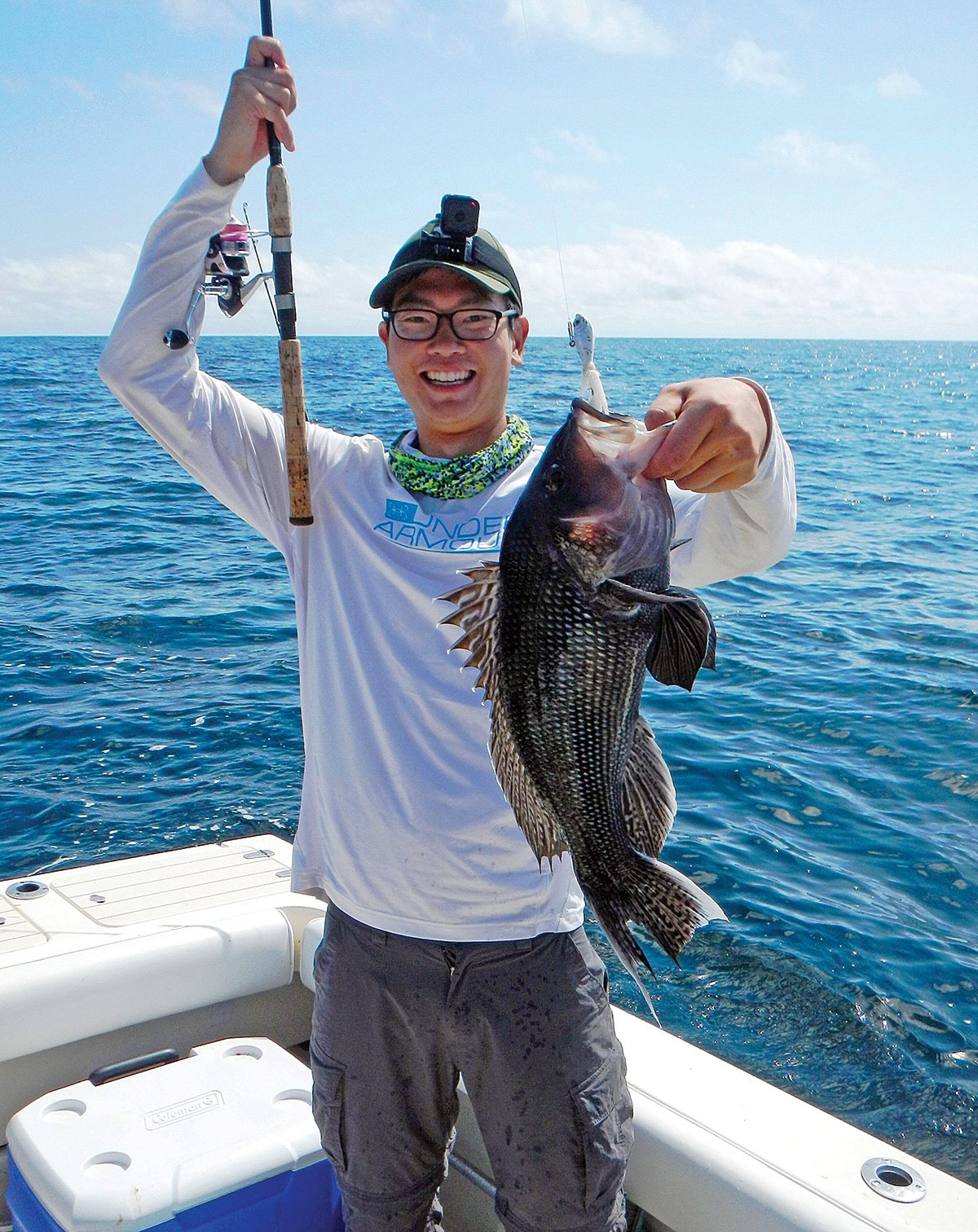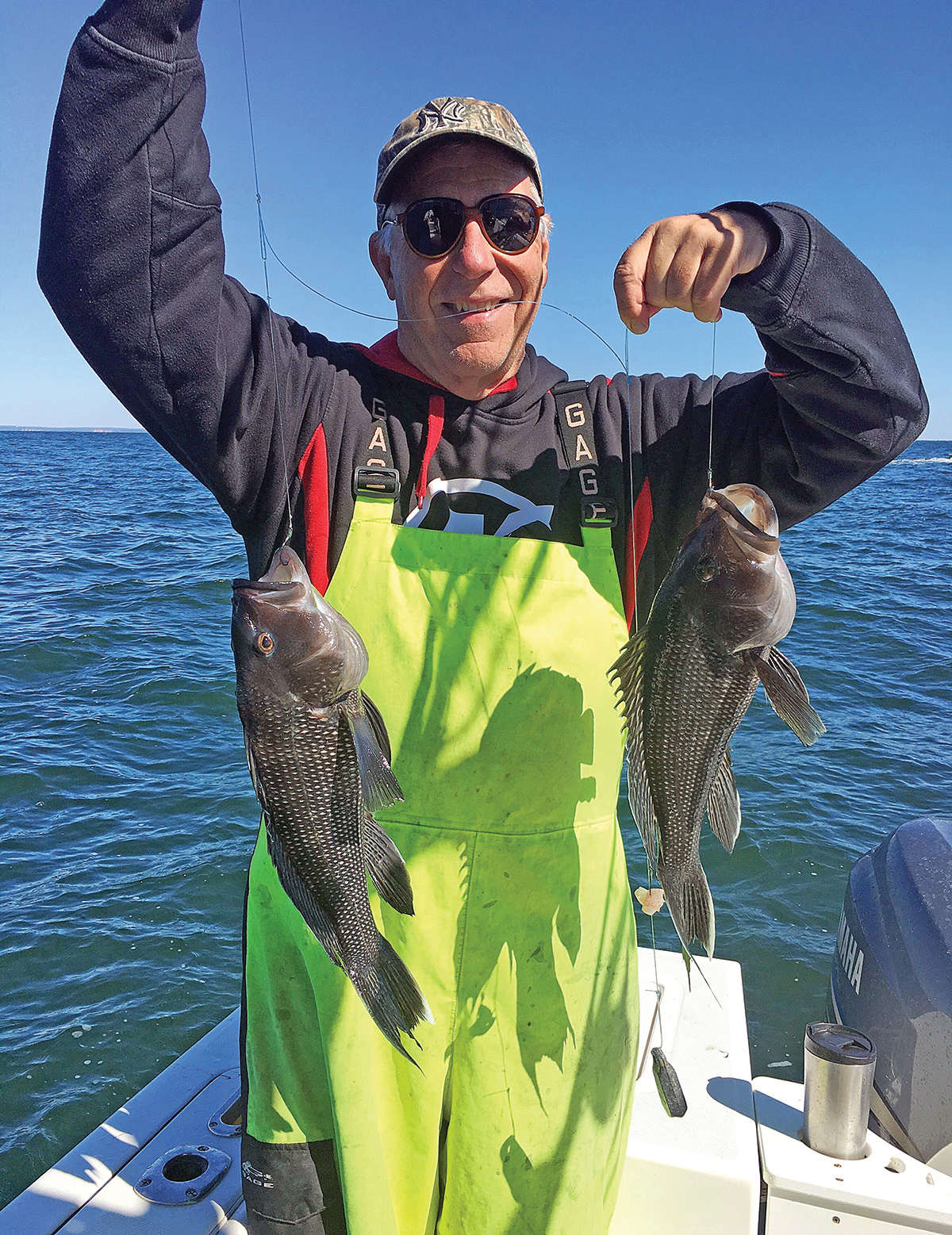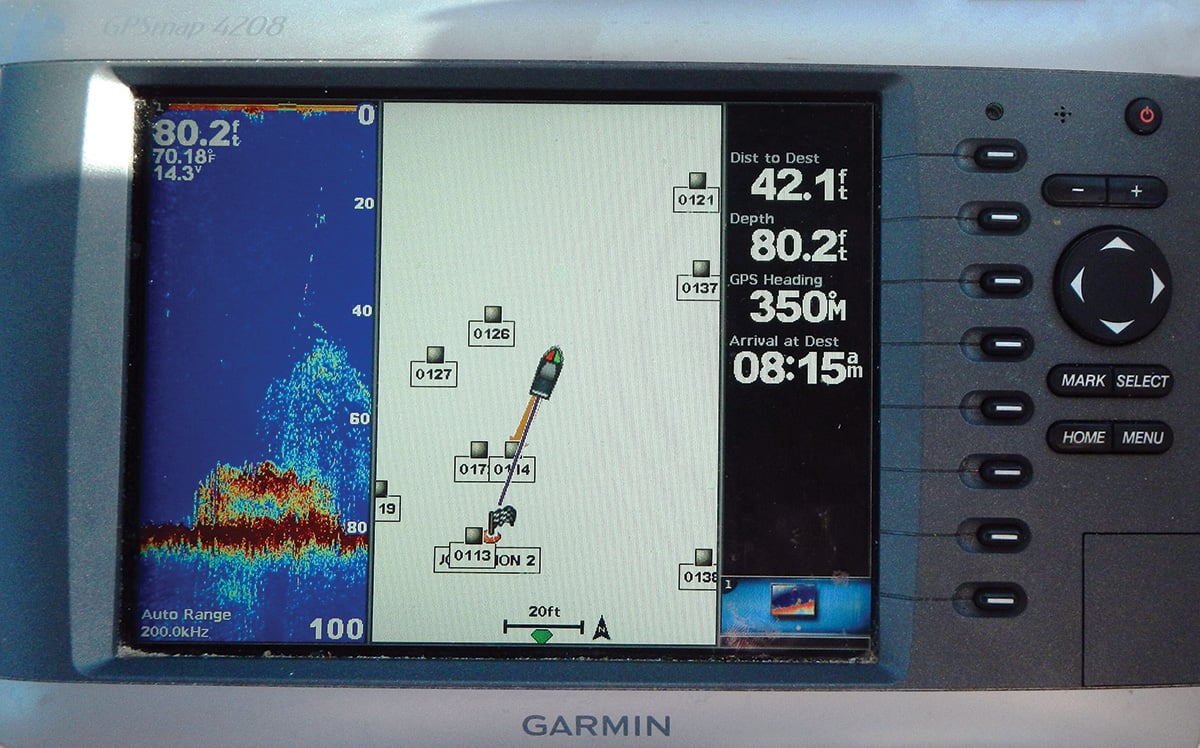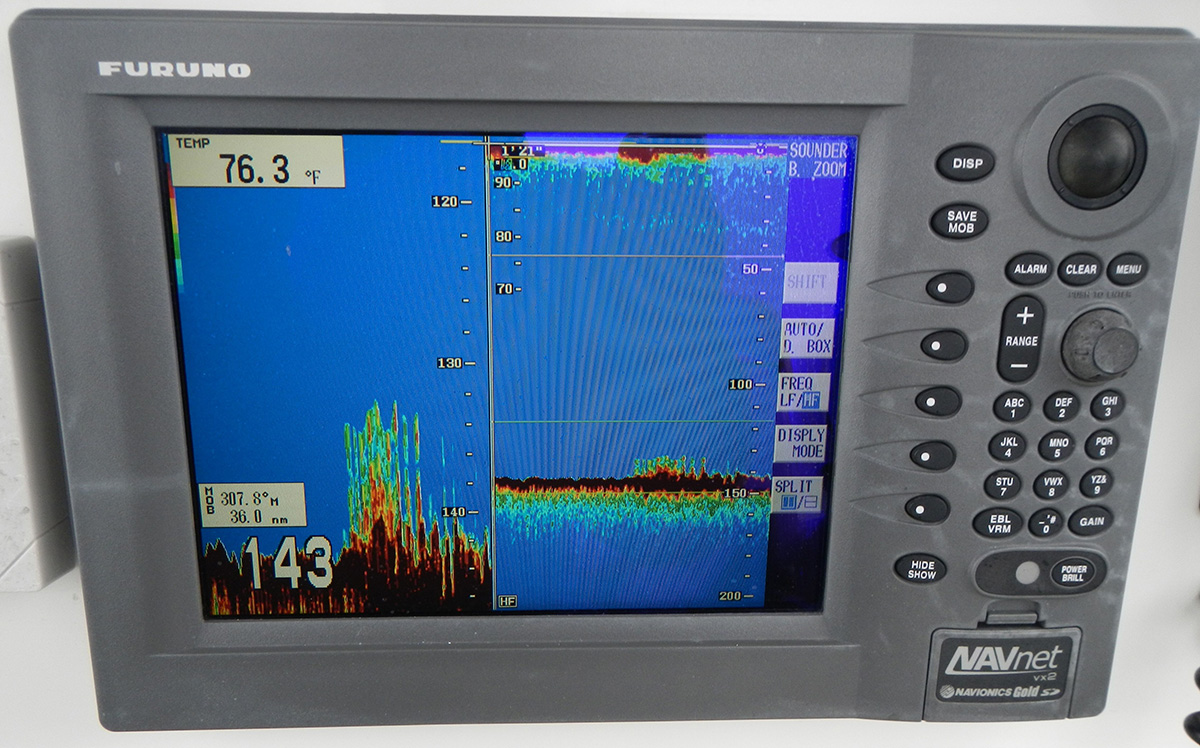
As the days get shorter and the nights get longe r, red hot fishing at local and near offshore wrecks and rock piles can send the thermometer climbing.
Fall wreck, reef and rock pile fishing is the story of two opposite migration patterns. The first is the exodus of the usual summer inshore species to the offshore wintering grounds and these include fluke, sea bass, porgies, bluefish, weakfish and stripers. The other “opposite” migration is that of the winter groundfish that move inshore, and these include cod, pollock, whiting, hake, winter flounder and blackfish. On occasion, there are those magical moments in time where the two points briefly intersect on wrecks and rock piles in 15-to-30 fathom waters for some of these transiting gamefish and the action at these locations can be totally off the charts. These trips are the stuff of legend that will have you entertaining fond memories for years to come.
Game Plan with Options
When planning a fall trip to my favorite wrecks and rock piles, I typically scan the latest intel channels like the Fisherman fishing reports, local internet angling chatter, area tackle shops and fellow charter boats anglers. Once I get a feel for what is happening in real time, I will refer back to 40-years of my own personal MarCeeJay fishing logs to ascertain if what has happened in the past will have any relation to what might happen again in the future. The third piece to the trip planning puzzle is to then find low traffic wrecks and bottom structure that is off the usual beaten path of recreational anglers and the party boat crowd. I will then identify and target a half-dozen potential hotspots in a relatively homogeneous area of ocean or LI Sound for that day’s focus and hope that the wind and seas are favorable for such a foray. If there’s too much traffic at my initial selection spot, or if the fish are in an uncooperative mood or simply AWOL, I will then shift to the second choice on the menu and move on. The key ingredient to late fall fishing is to keep to a managed timeline. You typically leave in the dark, come back in the dark and are at the whim of fickle weather patterns that will punish you for staying too long at places that are too far from home port. Be sure to give yourself enough time at the spots you’ve chosen to have the best chance for success.

Tackle for the Task
I seem to be in a constant state of evolution with my fishing tackle, but especially so with my bottom fishing and wreck gear. As rods and reels get smaller, stronger and lighter, it’s a challenge to keep up with all of the latest improvements and gadgets and stay within your entertainment budget. But like my wife, who is a fashion conscious woman with too many pairs of shoes, I am guilty of being an angler with too many fishing rods/reels, lol! These days, my favorite choice for general wreck and rock pile work is a graphite/fiberglass composite rod in the 6-to-6.5 foot range, armed with a trigger grip graphite seat and a conventional reel (with or without a level wind). I have not had a lot of luck with 100% graphite or boron rods and tend to break them with minimal effort during “high stick” maneuvers. The graphite/fiberglass blend rods are a lot more forgiving and can take extreme punishment from hefting large fish off the bottom in extreme conditions. The sensitivity trade-off is not significant, so I will always go for a graphite/fiberglass composite stick to eliminate any unplanned and unpleasant breakages out on the briny.

I have had a lot of success over the past few seasons with Penn’s moderately priced lineup of Rampage jigging rods, with the six-foot six-inch (30-80lb braid) and the six-foot two-inch (50-100 lb braid) models my favorites. These graphite/fiberglass modulus blanks are relatively strong and lightweight and can hold a lot of lead with their medium/heavy power and fast taper actions, but still sport a sensitive tip to feel those “ghost” pickups of wary bottom dwellers. They are also strong enough to deal with tuna jigging in case we run across a school of thunnus on our fall trips, which has happened often enough in the past. I also own and have employed Shimano Trevala, Shakespeare Ugly Stik Tiger Lite and Tsunami Ocean Max Gold rods, which are all equally adept at either jigging or dropping 16-ounces of lead to the bottom with a double or triple hook bait rig.
It’s hard to beat some of the latest graphite or precision machined aluminum reels that have hit the market over the past few seasons, and I have mixed in some old favorites with more contemporary gear. I currently go to sea with a mix of Penn 320LD (level wind), Avet SX5.3 G2, Maxel Ocean Max #09 and Penn Fathom 25NLD single speed, lever drag reels. Shimano, Daiwa, Okuma, Accurate and others all make wonderful gear and it’s a matter of taste and budget when choosing your rods and reels. When looking at the best gear ratios for either dancing a jig (6:1) or winching a fish up from the bottom (3.5/4:1), I normally compromise with a reel that is somewhere in the 4.5-5.3:1 gear ratio range to get the best of both worlds. Two speed reels tend to be too large/bulky, heavy and expensive for this simple wreck/reef/rock pile fishery, although there are a few exceptions to this generalization.
Super braid line rules when bottom dropping in depths of 60-feet of more due to its limited stretch and reduced hydro-dynamic profile. Keeping your super braid on the lighter side (30 to 40-pound test) typically reduces water resistance when fishing in heavy currents and allows you to hold the bottom with less lead, which translates to more vertical rod angles (less line in the water) and increased sensitivity to what’s going on down at the bottom with your baits. I spool up my reels with either 30 or 40-pound hi-vis super braid line with a 10-yard mono topshot and have had great results with Western Filament TUF-Line, PowerPro Maxcuarto, Maxima Braid 8 and Spiderwire Stealth. Once again, line choice is a personal thing, so whether you prefer 4-carrier or 8-carrier braid, hi-vis or low-vis, there are numerous manufacturers that make great products, so find one that you are comfortable with and get your reels ready to fish.

Techniques that Work
Snap-jigging aficionados would think of this wreck and structure fishing piece as being incomplete if I didn’t mention this up-and-coming technique. The Fisherman has published numerous references to snap-jigging on the Fisherman’s website, including some excellent video. Having been exposed to much of the snap-jigging phenomena over the past few years, I was determined to join the party this season and set up a dedicated snap-jigging outfit that consists of a Shakespeare 6.5-foot fast taper trigger grip Ugly Stik rod, matched with a Penn 955 International mini baitcasting reel spooled with 30-lb super braid. I have been able to hold bottom in waters up to 85-feet deep using either a 1-oz or 1.5-oz SPRO Prime bucktail jig, depending on the current flow, drift speed and depth. I am considering lightening up my running line on this combo to 20-lb super braid for next season. I have caught copious amounts of large sea bass and porgies on this setup fishing wrecks and structure in LI Sound north of Orient Point and on the east end this season, including the usual suspects like stripers, blues, fluke and weakfish. Most snap-jiggers that I have taken out for charters on my MarCeeJay typically employ a 6-to-6.5 foot medium power/fast taper spinning rod with a 3000-series reel spooled with 15-lb braid, using jigs in the ¾ to 1-ounce range. Snap-jigging can be really productive when working structure in waters less than 120-feet and I have seen enough of it with my own eyes to become a believer! The jigs typically catch the largest and most aggressive fish of the school, so if you are getting inundated with shorts, go to the jigs and solve the problem.
The classic dropper loop bottom fishing setup works great when fishing fall wrecks, reefs and rock piles. I typically attach a pre-made dropper loop set-up with either two or three hooks coming off the leader about a foot apart, with a perfection loop knot at the top and a single overhand loop knot at the bottom for the sinker. The single overhand knot is strong enough to hold the sinker, but will break or pull out when snagged into sticky bottom, saving the rest of the rig. I make these myself from tag ends of bulk spools of 40-lb mono in either dark green or camo (Quattro Plus). A 4-to-5 foot long total length leader gives the hooks enough space in between so that they don’t tangle. I will pre-tie a few dozen 2/0, 3/0 and 4/0 Octopus hooks on short 8-inch leaders and simply loop them around the dropper loops onto the main leader, which is attached to a 75-pound snap swivel for quick change ability. If you have to swap out an entire bottom rig, it can be done in a snap. If you need to replace one hook/leader in the chain, just cut it off and loop-in another from your pre-made batch. Keep it simple…you will probably be replacing a lot of rigs when fishing sticky structure and this is the most affordable and effective way to do it.
Some anglers prefer to adorn their dropper loop hooks with small squids or Mylar skirts for added attraction. I will usually tie on a small jig in the ½ to ¾-ounce range on one of my rig’s three dropper loops, which frequently gets more attention than the baited hooks. Depending on the species you are chasing, squid, fresh salted clams, crabs and fish strips will all produced results, so take a few different baits in case they are finicky that day.
Once you have found your preferred structure, the options are to drift, anchor, or to power drift/hold over the piece that has the most fish. If sea bass, porgies, cod, pollock, ling, tuna, bluefish, etc. are on the menu, drifting or power-holding over the structure can work great. If blackfish are the preferred species du jour, single anchoring or double anchoring might be the best plan, depending on sea conditions, depths and drift speeds. Use your echo sounder to find out if any fish are holding directly over the wreck or off to the side and then work the structure accordingly. I won’t anchor over a piece unless I have first caught a few fish on the initial drifts. Be advised that the fish you see on your screen might not be the ones you want…spiny dogfish are a total nuisance in the fall and tend to hang off the wrecks on the perimeter, so be sure to get right over the structure to do your prospecting.
Working the coastal structure in the late fall months is the last hurrah for many Fisherman readers before the doldrums of winter are upon us. Get out there and do something before it starts to snow…it’s going to be a long winter.




